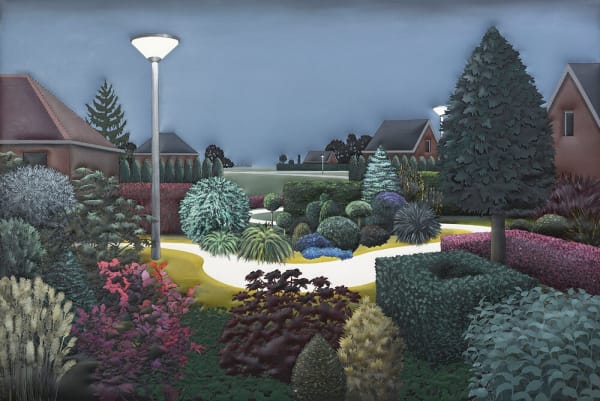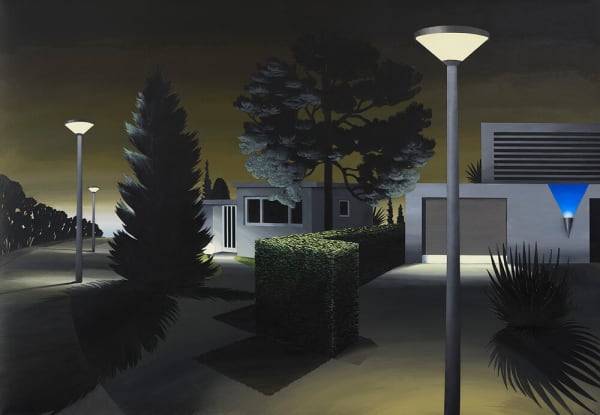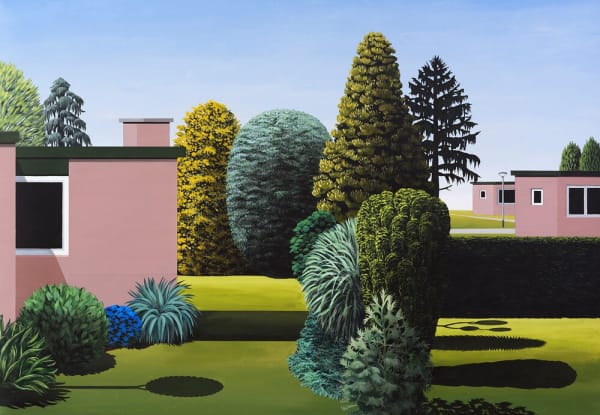ESTHER JANSSEN
@ESTHERJANSSEN_
“Ambiguous, Enchanting, Stifling”
Today’s feature to go live is the work of the fantastic Janssen! Her work, nothing like I’ve seen before, works to take the familiar banal environment and make it enchanting and unfamiliar. Each piece sits under an ‘Esther Atmosphere’. Her works are beautiful and intriguing.
We discuss dream projects, incredible collector stories, artists necessities, working structure, family histories and much more!
On her favourite historical artists: “All women who lived a deviating lifestyle. Whether it be writers, painters, sculptors. Women who dared to step off the path that society carved out for them.
Since I’ve always known I would never choose to have children, I am extra interested in female examples both in history and today, who live(d) a life without children, who thought and operated in an autonomous manner, no matter what the circumstances or fashion of the epoch. An example would be Georgia O’Keeffe, for her whole being, for how and where she chose to live her life.”
-
INTERVIEW
ESTHER I AM A HUGE FAN OF YOUR WORK AND CAN'T WAIT TO LEARN MORE ABOUT YOUR PRACTICE. Quick one TO START WITH, what 3 words would you use to describe your artwork
Ambiguous Enchanting Stifling
STIFLING IS AN INTERESTING WORD. SO, What is the most important aspect of your work?
I take the familiar banal environment and make it unfamiliar and enchanting.
I THINK THAT'S PERFECT. THESE FAMILIAR SCENES WE ALL KNOW OF WOODS AND HOMES DO FEEL MORE ISOLATED, BUT THEY ARE MAGICAL. What memorable responses have you had to your work?
People who tell me after having seen my work they start seeing ‘Esther Neighbourhoods’ or ‘Esther atmosphere’ in their own environment. People who tell me they see their environment with new eyes and experience a sense of beauty and intrigue that they did not experience before.
One response stands out: A befriended collector came to my studio to buy a small work. He told me he had to have a very high risk operation. He wanted this work installed in his hospital room, opposite his bed. If he survived the operation, that’s what he wanted to see when waking up. The painting now has a central place in his living room. When I am in doubt about the value and power of (my) art, i only have to recall this story.
And which artwork would you like people to remember you for?
The Neighbourhood no.1. It is the first work in which everything came together, subject, theme, skill, use of material, atmosphere, scale. It taught me what I am capable of.
What are you working on now ESTHER?
I am currently working on a sewn fake leather painting series called ‘The Silence’. A series of highly stylised enclosed gardens with mirroring, perfectly round ponds and walls of conifers that look like guards or curtains.
Simultaneously I am experimenting with technical solutions to continue my large scale Neighbourhood series in a manner that is easier on my hands.
THAT SOUNDS INCREDIBLE! What would be your dream project?
The first dream project would be an extension of what I am already doing: to one day be making The Neighbourhood no. 200 and to publish the whole series in a book.
The second dream project would be to make an all-encompassing fake leather indoor garden installation.
I LOVE THE SHOUND OF THAT BOOK, YOU MUST KEEP ME UPDATED! ESTHER, What is your studio like?
It measures 16 square meters, has a sloping ceiling and one very high clean wall. I made a scale model to find out how to maximise the use of this space. I like making tailored spatial solutions. Now it looks like a control room. Highly organised. To my own surprise I started making large works in this fairly small studio space.
What are your artist necessities?
Beside the obvious physical materials and tools:
• Artificial Leather
• Photoshop to sketch with colour planes instead of lines and to determine and fine tune colour, shadow and light. While working on a physical piece i often photograph the work and import it in Photoshop to try out what it needs by sketching over the digital photograph.
• Google Streetview, to scan neighbourhoods and collect types of gardens and houses by making screenshots. I like the slightly higher than human point of view in Streetview (due to the cameras being mounted on a tripod on top of the Google car). It generates a perspective that makes houses and streets look ‘cosy’.
DO YOU LISTEN TO ANYTHING WHILE YOU WORK?
Nowadays, during work I actually don't listen to external input. This has to do with the fact that all listening is now done through online apps and media, which makes it hard not to get distracted by other online temptations. I noticed it made me restless and less productive. I now regard working in silence as a welcome break from continuous media input. It also enables to hear what feedback on my work rises up from within. It can contain interesting clues which would otherwise have remained in the subconscious.
What does an average working day look like to you?
My working day always starts between 6 and 7 am. It has two variants: research/sketch days and the execution days. They differ as night and day.
In the research and sketch phase for new work, my days are fragmented. Stretches of super high concentration interspersed with messing around, procrastinating, avoidance of watching the sketches by tidying up the studio, going out for a walk, housekeeping. This phase is marked by uncertainty and lasts until the desired, yet never predictable breakthrough. A breakthrough means the threshold of “it is nothing” to “I can’t wait to see how it turns out!” gets crossed. That’s when I know enough to start the physical executive phase.
The executive phase means I get into a focussed, monomaniac mode. I start working when i get up and don’t stop till late at night. I have to force myself (or be reminded by my partner) to take a lunch break or go out for a walk. It doesn’t at all mean this phase is free of challenges and questions, but instead of procrastinating, problems are now confronted head on in one firm flowing movement. Two types of working days that are each others’ complete opposite regarding energy, confidence and drive.
Who or what are your biggest influences, and how do you find them?
My mother, father, stepmother and grandfather all are / were artists. Art has always been as naturally present as table and chairs were. When I grew up, a reproduction of a Hiroshige woodcut hung beside our kitchen table. It depicted an eagle up close in flight, floating high above an abstracted landscape. Every time i looked at it it challenged my mind because i couldn’t figure out the anatomy of the eagle, its wings were twisted, it was impossible to trace them from tip to body. Yet the image was very convincing and powerful. It never ceased to captivate, precisely because I couldn’t fully understand it. It made my eyes and mind dance. In my own work i likewise aim to make the viewers’ eyes and mind dance.
My father also made woodcuts. As a teenager I sometimes helped him print editions with a large press. I saw the images being build up layer by layer over and over again and really got to know them. The way he used hardcut shadows to build a pictorial space must have influenced me.
Then there is Hergé, the TinTin books, I loved them as a child and kept rereading them up to this day. It’s likely they influenced the combination of clarity and detail in my work.
My understanding of colour expanded immensely when Chris Ware published the graphic novel Jimmy Corrigan in 2000. I was so impressed by the sublime universe he created. The moods he evoked through his subtle tonal use of color, was an eye-opener.
The freedom, insights, playfulness, spirit and humor of David Hockney never cease to energise me.
The ominous, ambiguous atmosphere and art direction from the series and films by David Lynch and Stanley Kubrick had a big influence.
The materiality from Michael Raedecker, a painter who has a fashion background, whose works i first saw in 1997 blew me away. Those paintings later inspired my own experiments with deviating materials to paint.
-
TALK TO ME ABOUT THEMES!
A main theme in my work deals with the illusion that we can manufacture and commodifiy every aspect of life, of nature and even our dreams and happiness.
This leads to a growing discrepancy between dreamed ideal and lived outcome, and to complete alienation of man.
On industrial scale, manufacturers use the power of illusion to seduce us into buying their products, buying happiness. In my work I aim to counter that fraud by presenting an illusion that does not disappoint when unveiled, an illusion that reveals itself as an illusion. In that double role of being illusion-disillusion it has the potential to generate a feeling of possibility instead of emptiness. The perfect illusion-disillusion field should generate a transcending space where judgement is suspended and even the most banal subjects reveal their sacred essence.
Subsequently the banal and the sacred is another more humorous line running through my work. In my recent landscapes I play a little with the commodification of gardens and frontyards. People’s longing to create their own private paradise combined with their utter lack of space and time to realise and sustain it is commodified in the shape of standardised pre-shaped plants and simplified designs which distantly echo classicist gardens and ancient depictions of the garden of Eden. It results in modern day gardens that are completely uniform, low in cost and maintenance and even partly made of plastic. Yet, in my paintings they do feel like paradise.
A third thread in my work has to do with the fact that our digital online environment is rapidly becoming the space where we spent most of our time. Augmented reality is already putting extra layers on top of our offline world. The real, tangible world risks becoming the less colourful, less exciting version of the online world. I take this ‘less spectacular mundane environment’ and show how spectacular it can be when you really look. I aim not to augment reality but to augment perception. To augment sensitivity to natural phenomena that perform a free daily spectacle of shifting light, colour and shape, transforming the mundane surroundings in a magical theatre. Not by adding layers and 'suspension of disbelief', but by subtracting layers of noise and suspending conditioned knowledge.
What is one thing people would be surprised to know about you?
I have a strictly private library of handwritten and hand typed copies of books, after copying them I bind them the old school way, in a size and material of my preference, for sheer personal pleasure. I rarely show them because it mostly freaks people out.
What is the best piece of advice you have ever been given?
Without a doubt that has been in the third year of the Design Academy. A new headteacher came to the department, Anton Beeke, a Dutch autodidact graphic designer who was famous in Holland and abroad for his radical and powerful (literally) graphic design. We connected without many words and after he saw my work, which was a bit rebellious, he said to me: You should do your own stuff, not the teachers’ assignments. He offered me complete freedom to work autonomously outside of the academic curriculum. In the end I graduated with honors with art at an academy for design. The trust he had placed in me with those words was the start of trusting myself as an artist.
What advice would you give?
Know your cycle. Yes, the hormonal one.
If you are about to throw your work or whole career in the bin exclaiming everything is worthless, do check your calendar. Nothing should be thrown away, or in my case even assessed at all, during the last period of a menstruation cycle. Over the years this pattern of undermining my own work became so obviously linked to my hormonal cycle that I learned what to do best when. When to pose the tough questions, when to try something new, when to do very concrete and physically demanding things like preparing canvasses, or cleaning out the studio. I learned to ride my cycle.
-
-
"All women who lived a deviating lifestyle. "
If you could have a meal with any artist from any time: what would the meal be?
A Vietnamese dish with lots of fresh herbs that smells like a garden and leaves you feeling light instead of heavy.
who would it be with?
The anonymous Roman fresco painter who painted the black room at Boscotrecase in Pompeii in the 1st century before Christ. (on permanent display in The Metropolitan Museum NY)
Why?
When i first saw the high res images of this room I couldn’t believe what I was seeing, it shocked me in the best possible way. The frozen time capsule effect, caused by the volcanic eruption, is of course mind-blowing enough in itself. But to me, also on a formal level, it’s among the most radically modern, beautiful, delicate and mysterious pieces of art I know. The bold use of black: which makes up for 90% of the walls, is lifted by a most delicate and fragile architectural structure, painted in trompe-l’oeil. Zooming in on that structure one discovers playful miniature tableaus of Egyptian figures, swans, baldachins… It is advanced and sophisticated without being contrived. I would be interested to hear how the artist approached this specific work… and what vocabulary he would use to talk about it. Could two artists from such different historical periods bridge a gap of 2000 years by talking about something as timeless as painting? How did he perceive being an artist? Would I tell him about the volcanic eruption and subsequent complete burial of Pompeii? Would I tell him how much Pompeii means to us today? Or would that be too inconceivable and make the time gap insurmountable? I mean, how could i possibly tell him his frescos now serve as my desktop picture?
What is your greatest indulgence in life other than creating?
Reading. Physical books. The classics of world literature and also non-fiction, philosophy. I want to understand what forms the core of being human, see the bigger picture.. I want to be able to discern which values and issues are fundamental and timeless and which are fleeting and unnecessary to waste my time on.
Favourite historical female artist?
All women who lived a deviating lifestyle. Whether it be writers, painters, sculptors. Women who dared to step off the path that society carved out for them. Since I’ve always known I would never choose to have children, I am extra interested in female examples both in history and today, who live(d) a life without children, who thought and operated in an autonomous manner, no matter what the circumstances or fashion of the epoch. An example would be Georgia O’Keeffe, for her whole being, for how and where she chose to live her life.
Favourite current practicing female artists?
Louisa Gagliardi @louisagagliardi
Sanam Khatibi @untilthelilacsturnblack
Farah Atassi @farah_atassi_painter
Katharina Grosse @katharina_grosse
Shaina McCoy @wallflowermccoy
Genieve Figgis @genievefiggis
Tauba Auerbach @tau_au
Jordan Kasey @jordankaseyjordankasey
Keetje Mans @keetjemans
Olga Fedorova @olgamikhfedorova
Jennifer J. Lee @jenny_j_lee
Henni Alftan @hennialftan
Robin F. Williams @robinfrancescawilliams
Emily Ludwig Shaffer @emmerglemmer
Marlene Dumas @marlenedumas
Maude Maris @maudemaris
Elizabeth Glaessner @eglaessn
Katherina Olschbaur @kat_olshbaur
Jessie Makinson @jessie_makinson
Amy Bennett @amybennettstudio
Danica Lundy @danicalundy






